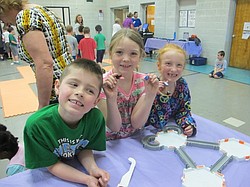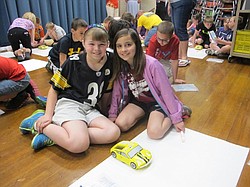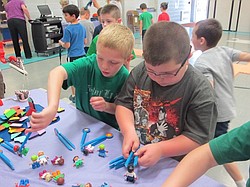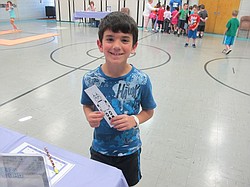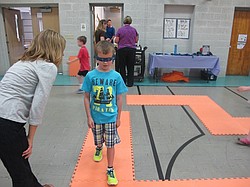North students learn about robots
Neighbors | Adrienne Crissman.North Elementary students, from left, Luke Thomas, Ashlee Tusinac and Mya Scott participated in one of the many different activities during Carnegie Science Day May 16.
Neighbors | Adrienne Crissman.Cassandra Aey and Isabella Cherry programed a robotic car during the Carnegie Science Day May 16.
Neighbors | Adrienne Crissman .North Elementary students Alex Stefek and Aiden Baker used tweezers to simmulate a robot's hands during the Carnegie Science Day May 16.
Neighbors | Adrienne Crissman.Lucas Osline displayed his binary code bookmark at the Carnegie Science Day May 16.
Neighbors | Adrienne Crissman.Logan Allen took directions to get through the maze at Carnegie Science Day May 16.
By ADRIENNE CRISSMAN
Students at North Elementary School learned about robots during Carnegie Science Day May 16.
The students attended the “Rockin Robots: World Tour” assembly presented by Michaela Williams and Marilyn Fitzsimmons of Carnegie Science Center in Pittsburgh. Williams started the assembly by asking students if they could have a dream robot that would do anything for them, what would it do.
“Almost all of them said their homework,” said Williams.
A robot named Quasi became the children’s guide on the journey. He introduced them to different robots hard at work.
“The program teaches kids about the things robots can do to help us and the environment,” said Fitzsimmons
Throughout the program, the students could interact with Quasi and the other robots. The students participated in a song in binary code and a gyroscope demonstration.
“The program proves that you don’t need to be an expert in science to use robots,” said Williams. “Machinery and robots are relatable.”
After the assembly, the students were able to participate in many robot-related activities. They built a binary code bookmark of their birthday, simulated a robot’s arms using tweezers to pick up different items, followed the directions of a robot to get through a maze and more.
One activity the students participated in allowed them to program a robotic car to turn and stay on a mat. The activity used curves and angles to help students complete a set of challenges.
 43
43

